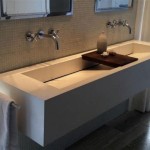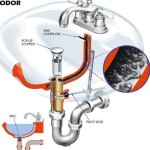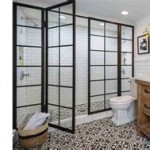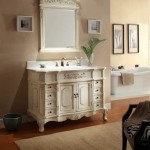Bathroom Sink Sit On Counter: A Comprehensive Guide
The bathroom sink sit on counter, also known as a vessel sink, has emerged as a popular design choice in contemporary bathrooms. Characterized by its placement directly on top of the counter rather than being recessed into it, this style offers a unique aesthetic appeal and several practical considerations. This article delves into the various aspects of bathroom sink sit on counter designs, including materials, installation, pros and cons, and key considerations for choosing the right model.
Aesthetic and Design Considerations
The primary draw of a bathroom sink sit on counter is its visual impact. It acts as a focal point in the bathroom, contributing to a modern and sometimes minimalist aesthetic. The exposed basin showcases the material and craftsmanship of the sink itself, turning a functional fixture into a decorative element. The variety of shapes, sizes, and materials available allows homeowners to personalize their bathroom design significantly. Options range from classic circular or rectangular shapes to more avant-garde asymmetrical forms. Materials such as ceramic, glass, stone, metal, and even concrete offer a diverse range of textures and colors to complement any bathroom style.
The design should complement the overall bathroom theme. In a modern bathroom, a sleek, geometric vessel sink in white ceramic or stainless steel might be ideal. For a more rustic or farmhouse-style bathroom, a hammered copper or natural stone sink could be a better fit. Consistency in style and color palette is crucial for a cohesive and visually appealing bathroom design. Consider the countertop material as well. A contrasting countertop material can further accentuate the sink, while a complementary material can create a more unified look.
The height of the counter and the sink combined is a crucial ergonomic consideration. Ideally, the top rim of the sink should be approximately 31 to 36 inches from the floor. If the countertop is already at a standard height, a shorter vessel sink might be necessary to ensure comfortable use. Conversely, a taller vessel sink can compensate for a lower countertop. Paying attention to these measurements prevents back strain and ensures that the sink is comfortable for all users.
Lighting also plays a vital role in showcasing the beauty of a vessel sink. Strategic placement of lighting fixtures can highlight the sink's shape and texture, creating a more dramatic effect. Undercabinet lighting can also provide subtle illumination, adding to the overall ambiance of the bathroom. Natural light is always beneficial, but artificial lighting should be carefully planned to enhance the sink's aesthetic appeal.
Installation and Plumbing Requirements
Installing a bathroom sink sit on counter differs significantly from installing a traditional undermount or drop-in sink. The primary difference lies in the drain placement. Vessel sinks typically require a longer tailpiece extension on the drain to reach the P-trap beneath the counter. This is because the drain outlet is located further above the counter surface compared to other sink types.
The installation process begins with preparing the countertop. A hole needs to be drilled for the drain, and in some cases, a separate hole for the faucet. The size and placement of these holes must be precise to ensure a secure and watertight fit. A template is usually provided with the sink to guide the drilling process. It is highly recommended to consult the manufacturer's instructions for specific measurements and recommendations.
Once the holes are drilled, the sink can be placed on the countertop. Most vessel sinks do not require any additional support or mounting brackets. However, some models may benefit from a bead of silicone sealant applied to the base of the sink to prevent movement and create a watertight seal. The sealant should be applied evenly and any excess wiped away immediately.
Connecting the drain is the next crucial step. The longer tailpiece extension is essential to connect the sink drain to the P-trap. Ensure that all connections are tightened securely to prevent leaks. Similarly, the faucet installation requires careful attention. If a deck-mounted faucet is used, it needs to be installed before the sink is placed on the countertop. If a wall-mounted faucet is chosen, the plumbing needs to be roughed in at the correct height and distance from the sink. The faucet's spout should reach far enough to extend over the sink basin without causing splashing. All plumbing connections should be inspected for leaks before the installation is considered complete.
Professional installation is often recommended for vessel sinks, especially for those unfamiliar with plumbing. Incorrect installation can lead to leaks, water damage, and other costly problems. A qualified plumber can ensure that the sink is installed correctly and that all plumbing connections are secure and up to code. This can save time, money, and frustration in the long run.
Pros and Cons of Bathroom Sink Sit On Counter Designs
Like any design element, bathroom sink sit on counter designs offer both advantages and disadvantages. Understanding these pros and cons can help homeowners make informed decisions about whether this style is the right fit for their bathroom.
One of the primary advantages is the aesthetic appeal. Vessel sinks can transform a mundane bathroom into a stylish and sophisticated space. The wide variety of materials, shapes, and sizes allows for a high degree of customization and personalization. They can be a focal point, adding character and visual interest to the bathroom.
Another advantage is the ease of installation, in some cases. Compared to undermount sinks, vessel sinks often require less countertop modification. This can simplify the installation process and potentially reduce costs. However, it is important to note that proper plumbing connections are still essential for a successful installation.
Furthermore, vessel sinks can offer more counter space. Since the sink sits on top of the counter, it does not consume as much surface area as a recessed sink. This can be particularly beneficial in smaller bathrooms where counter space is limited. However, it is important to consider the overall size of the sink and countertop to ensure that there is still adequate space for toiletries and other items.
However, there are also several potential drawbacks to consider. One of the most common concerns is the height of the sink. As mentioned earlier, the combined height of the counter and sink can make the sink uncomfortable to use, especially for children or shorter adults. Careful consideration of the countertop height and sink dimensions is crucial to avoid this issue.
Another potential disadvantage is the difficulty of cleaning. The area around the base of the sink can be difficult to reach and clean, potentially leading to the buildup of dirt and grime. Regular cleaning is necessary to maintain the sink's appearance and prevent the growth of mold or mildew. Using a sealant around the base of the sink can help to prevent water from seeping underneath and causing damage.
Splashback is also a common issue with vessel sinks. The raised design can sometimes cause water to splash onto the surrounding countertop and floor. Choosing a sink with a deeper basin and a faucet with a properly angled spout can help to minimize splashback. A backsplash can also be installed to protect the wall behind the sink.
Finally, the cost of vessel sinks can be higher than that of traditional sink styles. This is due to the more intricate designs and higher-quality materials often used in their construction. However, the added aesthetic appeal and potential increase in home value may justify the higher cost for some homeowners. It is important to weigh the cost against the benefits and consider the overall budget for the bathroom renovation.
Key Considerations for Choosing a Bathroom Sink Sit On Counter
Selecting the right bathroom sink sit on counter requires careful consideration of several factors. The following key points can guide homeowners in making an informed decision that aligns with their needs and preferences.
First and foremost, consider the size and shape of the sink. The sink should be proportionate to the size of the bathroom and the countertop. A large sink in a small bathroom can overwhelm the space, while a small sink in a large bathroom may look out of place. Choose a shape that complements the overall design aesthetic of the bathroom. Circular sinks tend to have a softer, more organic feel, while rectangular sinks offer a more modern and geometric look. Asymmetrical shapes can add a unique and artistic touch to the bathroom but may not be suitable for all styles.
Secondly, choose a material that is durable, easy to clean, and aesthetically pleasing. Ceramic and porcelain are popular choices due to their durability, stain resistance, and wide range of colors and finishes. Glass sinks offer a sleek and contemporary look but can be more susceptible to scratches and chips. Stone sinks provide a natural and rustic feel but may require more maintenance to prevent staining. Metal sinks, such as copper or stainless steel, are durable and stylish but can be prone to water spots and fingerprints. Consider the material's properties and maintenance requirements before making a decision.
Thirdly, select a faucet that is compatible with the sink and countertop. Deck-mounted faucets are the most common choice for vessel sinks, as they can be easily installed on the countertop next to the sink. Wall-mounted faucets offer a cleaner and more minimalist look but require more extensive plumbing. The faucet's spout should reach far enough to extend over the sink basin without causing splashing. The faucet's style should also complement the sink's design. A modern sink pairs well with a sleek, minimalist faucet, while a rustic sink looks best with a more traditional faucet.
Finally, consider the overall budget for the bathroom renovation. Vessel sinks can range in price from relatively inexpensive to quite expensive, depending on the material, size, and design. Set a budget before starting the shopping process and stick to it. Remember to factor in the cost of the sink, faucet, plumbing, and installation. Shopping around and comparing prices from different retailers can help to find the best deals. Investing in a high-quality sink can add value to the home and provide years of enjoyment.
By carefully considering these factors, homeowners can choose a bathroom sink sit on counter that enhances the aesthetic appeal, functionality, and value of their bathroom.

Pros Cons Of A Vessel Sink

Complete Buyers Guide To Countertop Bathroom Basins

Vidaxl Wash Basin Vanity Sink Countertop Natural River Stone Oval Industrial Bathroom Sinks By Vida Xl International B V Houzz In 2024

Lisse 14 5 Round Concrete Vessel Bathroom Sink In Dark Grey Stone Sinks

Complete Buyers Guide To Countertop Bathroom Basins

Lixil

16 Amazing Ideas For Countertop Bathroom Basins Basin

Countertop Basins Bathroom Sinks Qs Supplies

Bathroom Vanity Idea An Open Shelf Below The Countertop 17 Pictures

Pin On Casa Junho 2024
Related Posts







